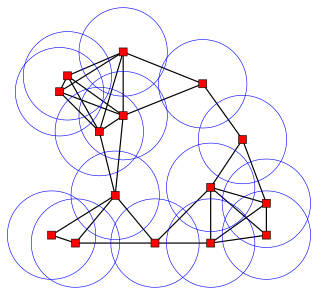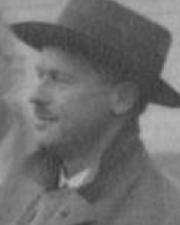Related Research Articles

A tessellation or tiling is the covering of a surface, often a plane, using one or more geometric shapes, called tiles, with no overlaps and no gaps. In mathematics, tessellation can be generalized to higher dimensions and a variety of geometries.
The Kepler conjecture, named after the 17th-century mathematician and astronomer Johannes Kepler, is a mathematical theorem about sphere packing in three-dimensional Euclidean space. It states that no arrangement of equally sized spheres filling space has a greater average density than that of the cubic close packing and hexagonal close packing arrangements. The density of these arrangements is around 74.05%.

Discrete geometry and combinatorial geometry are branches of geometry that study combinatorial properties and constructive methods of discrete geometric objects. Most questions in discrete geometry involve finite or discrete sets of basic geometric objects, such as points, lines, planes, circles, spheres, polygons, and so forth. The subject focuses on the combinatorial properties of these objects, such as how they intersect one another, or how they may be arranged to cover a larger object.

Ludwig Georg Elias Moses Bieberbach was a German mathematician and leading representative of National Socialist German mathematics.

Hugo Hadwiger was a Swiss mathematician, known for his work in geometry, combinatorics, and cryptography.

Euclidean plane tilings by convex regular polygons have been widely used since antiquity. The first systematic mathematical treatment was that of Kepler in his Harmonices Mundi.
Hilbert's eighteenth problem is one of the 23 Hilbert problems set out in a celebrated list compiled in 1900 by mathematician David Hilbert. It asks three separate questions about lattices and sphere packing in Euclidean space.
László Fejes Tóth was a Hungarian mathematician who specialized in geometry. He proved that a lattice pattern is the most efficient way to pack centrally symmetric convex sets on the Euclidean plane. He also investigated the sphere packing problem. He was the first to show, in 1953, that proof of the Kepler conjecture can be reduced to a finite case analysis and, later, that the problem might be solved using a computer.

In geometry, the hexagonal tiling or hexagonal tessellation is a regular tiling of the Euclidean plane, in which exactly three hexagons meet at each vertex. It has Schläfli symbol of {6,3} or t{3,6} .

In geometry, the square tiling, square tessellation or square grid is a regular tiling of the Euclidean plane. It has Schläfli symbol of {4,4}, meaning it has 4 squares around every vertex. Conway called it a quadrille.

In geometry, a Cairo pentagonal tiling is a tessellation of the Euclidean plane by congruent convex pentagons, formed by overlaying two tessellations of the plane by hexagons and named for its use as a paving design in Cairo. It is also called MacMahon's net after Percy Alexander MacMahon, who depicted it in his 1921 publication New Mathematical Pastimes. John Horton Conway called it a 4-fold pentille.

In geometry, a pentagonal tiling is a tiling of the plane where each individual piece is in the shape of a pentagon.

In geometry, a honeycomb is a space filling or close packing of polyhedral or higher-dimensional cells, so that there are no gaps. It is an example of the more general mathematical tiling or tessellation in any number of dimensions. Its dimension can be clarified as n-honeycomb for a honeycomb of n-dimensional space.
Geometry is a branch of mathematics concerned with questions of shape, size, relative position of figures, and the properties of space. Geometry is one of the oldest mathematical sciences.

In geometry, a shape is said to be anisohedral if it admits a tiling, but no such tiling is isohedral (tile-transitive); that is, in any tiling by that shape there are two tiles that are not equivalent under any symmetry of the tiling. A tiling by an anisohedral tile is referred to as an anisohedral tiling.

The smoothed octagon is a region in the plane found by Karl Reinhardt in 1934 and conjectured by him to have the lowest maximum packing density of the plane of all centrally symmetric convex shapes. It was also independently discovered by Kurt Mahler in 1947. It is constructed by replacing the corners of a regular octagon with a section of a hyperbola that is tangent to the two sides adjacent to the corner and asymptotic to the sides adjacent to these.

A set of prototiles is aperiodic if copies of the prototiles can be assembled to create tilings, such that all possible tessellation patterns are non-periodic. The aperiodicity referred to is a property of the particular set of prototiles; the various resulting tilings themselves are just non-periodic.

The Voderberg tiling is a mathematical spiral tiling, invented in 1936 by mathematician Heinz Voderberg (1911-1945). Karl August Reinhardt asked the question of whether there is a tile such that two copies can completely enclose a third copy. Voderberg, his student, answered in the affirmative with Form eines Neunecks eine Lösung zu einem Problem von Reinhardt ["On a nonagon as a solution to a problem of Reinhardt"].
References
- 1 2 3 4 5 Maier, W. (1942), "Karl Reinhardt", Jahresbericht der Deutschen Mathematiker-Vereinigung, 52: 56, ISSN 0012-0456
- 1 2 3 4 5 6 O'Connor, John J.; Robertson, Edmund F., "Karl August Reinhardt", MacTutor History of Mathematics Archive , University of St Andrews
- ↑ Karl Reinhardt at the Mathematics Genealogy Project
- ↑ Graham, R. L. (1975), "The largest small hexagon" (PDF), Journal of Combinatorial Theory , Series A, 18 (2): 165–170, doi: 10.1016/0097-3165(75)90004-7
- ↑ Bezdek, A.; Fodor, F. (2000), "On convex polygons of maximal width", Archiv der Mathematik, 74 (1): 75–80, doi:10.1007/PL00000413, MR 1728365, S2CID 123299791
- ↑ Hare, Kevin G.; Mossinghoff, Michael J. (2019), "Most Reinhardt polygons are sporadic", Geometriae Dedicata , 198: 1–18, arXiv: 1405.5233 , doi:10.1007/s10711-018-0326-5, MR 3933447, S2CID 254510721
- ↑ Reinhardt, Karl (1928-01-01), English: 1928 mathematics paper on the decomposition of Euclidean spaces into congruent polytopes - Proceedings of the Prussian Academy of Sciences. Physical-mathematical class (PDF), retrieved 2023-11-29
- ↑ Milnor, J. (1976), "Hilbert's problem 18: On crystallographic groups, fundamental domains, and on sphere packing", Mathematical developments arising from Hilbert problems (Northern Illinois Univ., De Kalb, Ill., 1974), Proceedings of Symposia in Pure Mathematics, vol. 28, Providence, Rhode Island: American Mathematical Society, pp. 491–506, MR 0430101
- ↑ Hales, Thomas (2017), The Reinhardt conjecture as an optimal control problem, arXiv: 1703.01352